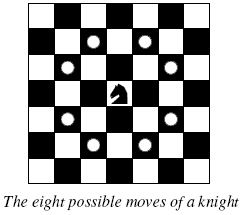Description
 Background
Background
The knight is getting bored of seeing the same black and white squares again and again and has decided to make a journey
around the world. Whenever a knight moves, it is two squares in one direction and one square perpendicular to this. The world of a knight is the chessboard he is living on. Our knight lives on a chessboard that has a smaller area than a regular 8 * 8 board, but it is still rectangular. Can you help this adventurous knight to make travel plans?
Problem
Find a path such that the knight visits every square once. The knight can start and end on any square of the board.
Input
The input begins with a positive integer n in the first line. The following lines contain n test cases. Each test case consists of a single line with two positive integers p and q, such that 1 <= p * q <= 26. This represents a p * q chessboard, where p describes how many different square numbers 1, . . . , p exist, q describes how many different square letters exist. These are the first q letters of the Latin alphabet: A, . . .
Output
The output for every scenario begins with a line containing "Scenario #i:", where i is the number of the scenario starting at 1. Then print a single line containing the lexicographically first path that visits all squares of the chessboard with knight moves followed by an empty line. The path should be given on a single line by concatenating the names of the visited squares. Each square name consists of a capital letter followed by a number.
If no such path exist, you should output impossible on a single line.
If no such path exist, you should output impossible on a single line.
Sample Input
3 1 1 2 3 4 3
Sample Output
Scenario #1: A1 Scenario #2: impossible Scenario #3: A1B3C1A2B4C2A3B1C3A4B2C4
题意:给你国际象棋棋盘的大小 问你马从其中一格出发能不能走完所有的格子
如果可以按字典序输出经过的路径
一个dfs很简单的题 但是要输出路径 那么马走的顺序就要按着字典序 这个弄清楚之后就会很简单了
ac代码:
#include<iostream>
#include<cstdio>
#include<algorithm>
#include<cstring>
#include<queue>
using namespace std;
int p,q;
int cnt;
int sum;
int flag;
int m[30][30];
char str1[100];
int str2[100];
int dx[10]={-2,-2,-1,-1,1,1,2,2};
int dy[10]={-1,1,-2,2,-2,2,-1,1};
void dfs(int xx,int yy)
{
if(flag == 1)
return ;
if(m[xx][yy] == 0)
{
str1[cnt] = 65+xx;
str2[cnt] = yy+1;
cnt++;
m[xx][yy] = 1;
if(cnt == sum)
{
flag = 1;
return ;
}
for(int i = 0; i < 8; i++)
{
if(xx+dx[i] >=0 && xx+dx[i] < q)
if(yy+dy[i] >= 0 && yy+dy[i] < p)
dfs(xx+dx[i],yy+dy[i]);
}
cnt--;//8种情况都不能接着向下走的时候,返回上一步
m[xx][yy] = 0;//当前的位置重置
}
else
return ;
}
int main()
{
int n;
while(~scanf("%d",&n))
{
for(int i = 0; i < n; i++)
{
scanf("%d %d",&p,&q);
printf("Scenario #%d:\n",i+1);
memset(m,0,sizeof(m));
sum = p*q;
flag = 0;
for(int j = 0; j < p; j++)
for(int k = 0; k < q; k++)
{
cnt = 0;
dfs(k,j);
if(flag == 1)
break;
}
if(flag == 0)
{
printf("impossible\n");
}
else
{
for(int j = 0; j < sum; j++)
{
printf("%c",str1[j]);
printf("%d",str2[j]);
}
printf("\n");
}
printf("\n");
}
}
return 0;
}


























 802
802

 被折叠的 条评论
为什么被折叠?
被折叠的 条评论
为什么被折叠?








